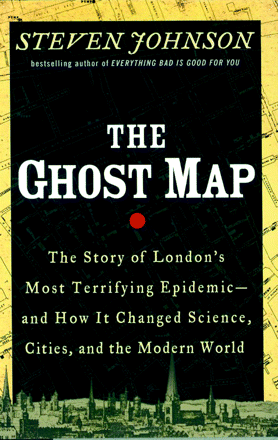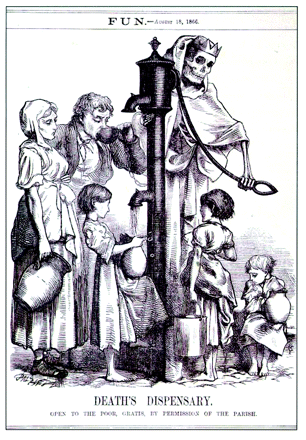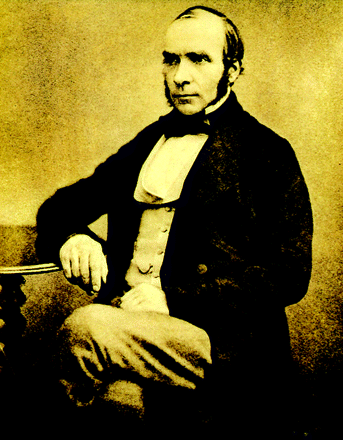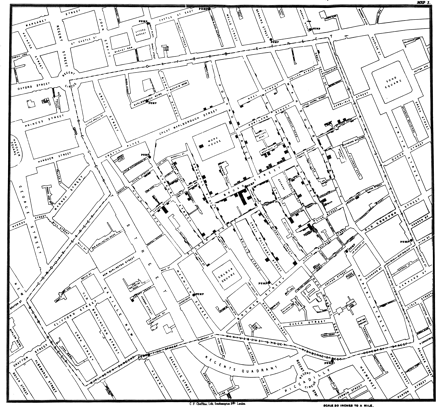A Sewage Treatment
- Christie Carrico, PhD, Executive Officer for ASPET.
The Ghost Map.

Steven Johnson. New York: Riverhead Books; 2006. 299 pages.$26.95 ISBN: 1594489254
The Ghost Map centers around the cholera epidemic that decimated the Soho (Golden Square) area of London in the summer of 1854. This epidemic became a milestone in the history of urban planning and disease control because it was ultimately brought under control through the efforts of two men who tracked the spread of the disease and identified the macroscopic source of the cholera. In the nineteenth century, cholera was a fairly common occurrence in urban areas, accepted as part of the natural coming and going of modern industrial life. In the Victorian Age, cholera was believed to be transmitted by noxious gases, or “miasma.” Indeed, cholera tended to occur under conditions in which the air was particularly odiferous, which prompted Edwin Chadwick (1800–1890), Commissioner of the Sewers, to remark, “All smell is disease.” This observation, and the Victorian belief in miasma as the source of disease in general, is understandable, given that poorer urban areas, like Soho, were sometimes literally flooded with pathogen-laden sewage. At that time, little or no differentiation was made between where waste entered the river and where drinking water came out. The Ghost Map thus chronicles a crucial event in the development of the industrial world-view of contagion and sewage management.
On August 28, 1854, the Lewis family infant, of 40 Broad Street, began the vomiting and diarrhea characteristic of cholera. The infant died within days, but not before her mother had soaked her soiled diapers in a bucket of water that she then dumped into the opening of the cesspool in front of the Lewis house, just feet away from one of several pumps that supplied drinking water to the Soho area. Within the next week, eighty-three more people would die from cholera within that area. If not for the sound and novel reasoning of the two characters at the center of the story, the death count would have been undoubtedly higher.
The Ghost Map tells the story of how Soho doctor John Snow and Soho minister Henry Whitehead effectively embarked upon a series of epidemiological investigations to pinpoint the Broad Street pump as the source of the cholera epidemic. Snow and Whitehead’s findings convinced the public health authorities, on September 8, to remove the handle from the Broad Street pump so that it could no longer dispense water. This seemingly prosaic chain of events may not at first sound like the stuff of a good story, but in fact they likely represent the first epidemiological study to identify and quell the cause of a modern public health catastrophe. The protagonists at the center of the story are all the more compelling against the backdrop of a medical community that considered disease to be primarily the result of “bad air.”
John Snow was a forty-two-year-old physician who is best known for making the correlation between the effectiveness of ether as an anesthetic and the dose of ether given. He developed an apparatus for carefully delivering a measured dose of ether to patients. As a careful experimentalist and thoughtful practitioner, he was by 1854 the most sought-after anesthesiologist in London. Serendipitously, his medical practice was in close proximity to the Golden Square cholera outbreak; he was thus called to administer what physical comforts he could to the sick and dying.
Henry Whitehead was an assistant curate at St. Luke’s Church, a caring and conscientious clergyman with an observant mind, open to new ideas. Whitehead’s charge was to visit the houses of the dead and dying and to minister to them and their families. In addition to these two protagonists, another key character to the story was William Farr, Editor of Weekly Returns of Deaths and Births, which not only kept a tally of area births, but also gave an accounting of regional deaths in terms of disease, parish, age, and occupation. These epidemiological parameters—especially pertaining to cause of death, age, and occupation—were Farr’s own innovations to the Weekly Returns, and they proved critical to Snow’s insights and conclusions concerning the 1854 cholera outbreak.
Drawing from their complementary perspectives on the afflicted community, Snow and Whitehead collectively came into contact with almost all of Soho during the cholera outbreak, and yet neither one contracted the disease. They also determined that there were pockets where the disease did not appear, such as the workhouse and the brewery. From their careful questioning and their study of the streets and houses where the death rate rose or held steady, Snow and Whitehead identified the Broad Street pump, long considered to provide the best-tasting water in Soho, as the source of the cholera outbreak. In the course of their investigation, the two men created the ghost map of the title, a map that apparently still appears in epidemiology texts today.
This real-life mystery story, in which the culprit is revealed to be a contaminated water pump rather than the stereotypical killer-on-the-loose, would make for a fascinating read, were it not for the long and somewhat dreary polemics that the author intersperses throughout the text. Johnson’s editorial analyses about the social effects of urbanization on the spread of disease tend to be heavy-handed. And the author’s love-hate affair with cities is pervasive, as he alternatively praises them on the one hand for the progress they foster, and then bemoans the doomsday scenarios that they threaten to unleash. The result is a book that is ostensibly a detective story but in fact becomes a dissertation on sewage and the associated challenges to urban planning and public health administration. The author gives detailed accounts of the waste scavengers in London in the nineteenth century, graphic descriptions of the London water and sewer systems as they underwent transformation, and a vivid litany of the physical ailments of the patient suffering from cholera. This is not a book to read immediately before or during dinner.
Although I enjoyed most of the book, including some of the public health digressions, I found the tone somewhat pedantic. Johnson’s understanding of public health issues and the science underlying them is significant, and his vocabulary is impressive. But I wonder how many people will understand his references to “Gradgrindian” reasoning; I certainly didn’t. In fact, I was compelled to do little more than skim the twenty-six–page epilogue, Broad Street Revisited, because it had little to do with the story of Whitehead and Snow, and instead rambled on about the city-planet, terrorism, 9/11, nuclear winter, avian flu, capitalism, and saving the earth. Nevertheless, if you can handle the author’s lectures, the account of Snow and Whitehead is a truly absorbing story.
Steven Johnson is a Distinguished Writer in Residence at New York University’s Department of Journalism. He writes for Wired, Discover, and The New York Times Magazine. He has written several other books including Everything Bad is Good for You and Mind Wide Open: Your Brain and the Neuroscience of Everyday Life.
- © American Society for Pharmacology and Experimental Theraputics 2007






